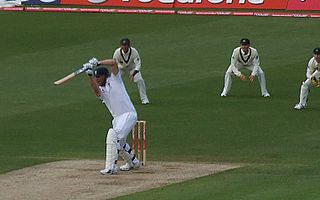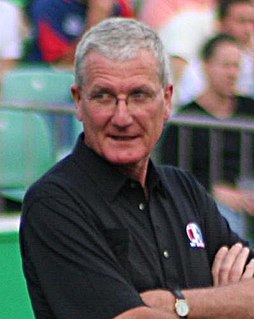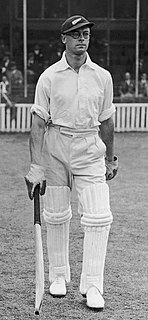
Sir Ian Terence Botham is an English cricket commentator and a former cricketer who has been chairman of Durham County Cricket Club since 2017. Widely regarded as one of the greatest all-rounders in cricket history, Botham represented England in both Test and One-Day International cricket. He played most of his first-class cricket for Somerset, and also for Worcestershire, Durham and Queensland. He was an aggressive right-handed batsman and, as a right arm fast-medium bowler, was noted for his swing bowling. He generally fielded close to the wicket, predominantly in the slips. In Test cricket, Botham scored 14 centuries with a highest score of 208, and from 1986 to 1988, he held the world record for the most Test wickets until overtaken by fellow all-rounder Sir Richard Hadlee. He took five wickets in an innings 27 times and 10 wickets in a match four times. In 1980, he became the second player in Test history to complete the "match double" of scoring 100 runs and taking 10 wickets in the same match.

Sir Richard John Hadlee is a New Zealand former cricketer, regarded as one of the greatest fast bowlers and all-rounders in cricketing history.

An all-rounder is a cricketer who regularly performs well at both batting and bowling. Although all bowlers must bat and quite a few batsmen do bowl occasionally, most players are skilled in only one of the two disciplines and are considered specialists. Some wicket-keepers have the skills of a specialist batsman and have been referred to as all-rounders, but the term wicketkeeper-batsman is more commonly applied to them, even if they are substitute wicketkeepers who also bowl.

The New Zealand national cricket team represents New Zealand in men's international cricket. Nicknamed the Black Caps, they played their first Test in 1930 against England in Christchurch, becoming the fifth country to play Test cricket. From 1930 New Zealand had to wait until 1956, more than 26 years, for its first Test victory, against the West Indies at Eden Park in Auckland. They played their first ODI in the 1972–73 season against Pakistan in Christchurch.

Shane Edward Bond is a New Zealand cricket coach and former cricketer and present bowling coach of Mumbai Indians, described as "New Zealand's best fast bowler since Sir Richard Hadlee". He represented New Zealand in Test, ODI and Twenty20 International cricket and played for Canterbury in New Zealand domestic cricket and Warwickshire in English domestic cricket. A right-arm fast bowler, his fastest recorded delivery was clocked at 156.4 km/h against India in the 2003 World Cup.

Robert George Dylan Willis was an English cricketer, who played for Surrey, Warwickshire, Northern Transvaal and England. A right-handed and aggressive fast bowler with a notably long run-up, Willis spearheaded several England bowling attacks between 1971 and 1984, across 90 Test matches in which he took 325 wickets at 25.20 runs per wicket, at the time second only to Dennis Lillee. He is England's fourth leading wicket taker as of 2019, behind Jimmy Anderson, Ian Botham and Stuart Broad. Willis took 899 first-class wickets overall, although from 1975 onwards he bowled with constant pain, having had surgery on both knees. He nevertheless continued to find success, taking a Test career-best eight wickets for 43 runs in the 1981 Ashes series against Australia, one of the all-time best Test bowling performances. He was a Wisden Cricketer of the Year for 1978.

George Giffen was a cricketer who played for South Australia and Australia. An all-rounder who batted in the middle order and often opened the bowling with medium-paced off-spin, Giffen captained Australia during the 1894–95 Ashes series and was the first Australian to score 10,000 runs and take 500 wickets in first-class cricket. He was inducted into the Australian Cricket Hall of Fame on 26 February 2008.

Walter Arnold Hadlee was a New Zealand cricketer and Test match captain. He played domestic first-class cricket for Canterbury and Otago. Three of his five sons, Sir Richard, Dayle and Barry played cricket for New Zealand. The Chappell–Hadlee Trophy, which is competed for by Test teams from New Zealand and Australia is named in honour of the Hadlee family and the Australian Chappell family.

Frederick Theodore Badcock, or Ted Badcock, was a New Zealand first-class and Test cricketer. Perhaps the best all-rounder in New Zealand in the inter-war period, he played seven Tests for New Zealand between 1930 and 1933, including New Zealand's inaugural Test in 1930. He is the only player to be out first ball in both innings on his Test debut.

Robert Smith Cunis played 20 Test matches for New Zealand as a pace bowler between 1964 and 1972, and was later coach of the New Zealand national team from 1987 to 1990. His son Stephen played cricket for Canterbury between 1998 and 2006.

Douglas Thomas Ring was an Australian cricketer who played for Victoria and Australia in 13 Tests from 1948 to 1953. In 129 first-class cricket matches, he took 426 wickets bowling leg spin, and he had a top score of 145 runs, which was the only century of his career.
Ian Charles Davis is a former Australian cricketer (batsman) who played in 15 Tests and 3 ODIs from 1973 to 1977. Ian retired from first-class cricket in 1984 then worked for Dunlop Slazenger until his retirement in 2010.

John Cowie was a New Zealand cricketer who played in nine Tests from 1937 to 1949. His Test opportunities were restricted by New Zealand's limited programme, and his cricket career was interrupted by World War II from 1939 to 1945. Following the 1937 tour of England, Wisden commented: "Had he been an Australian, he might have been termed a wonder of the age."
Dayle Robert Hadlee is a New Zealand former cricketer who played in 26 Tests and 11 ODIs from 1969 to 1978. He is the son of Walter Hadlee, the older brother of Sir Richard Hadlee and the younger brother of Barry Hadlee.

Timothy Grant Southee better known by Tim Southee, is a New Zealand international cricketer who plays all forms of the game. He is a right-arm fast-medium bowler and a hard-hitting lower order batsman. He is also the current vice-captain of the international team. He was one of New Zealand's youngest cricketers, debuting at the age of 19 in February 2008. On his Test debut against England he took 5 wickets and made 77 off 40 balls in the second innings. He plays for Northern Districts in the Plunket Shield, Ford Trophy and Super Smash as well as Northland in the Hawke Cup. He was named as New Zealand's captain for the first T20I against West Indies in place of Kane Williamson, who was rested for that game. The Blackcaps won that match by 47 runs.
The New Zealand cricket team toured England in the 1937 season. The team was the third from New Zealand to tour England, following those of 1927 and 1931, and the second to play Test matches. Three Tests were arranged: England won the second match at Manchester, and the games at Lord's and The Oval were drawn, the latter affected by rain. On the tour as a whole, the New Zealanders played 32 first-class matches, winning nine and losing nine, with 14 ending as draws.
The New Zealand cricket team toured England in the 1949 season. The team was the fourth official touring side from New Zealand, following those in 1927, 1931 and 1937, and was by some distance the most successful to this date. The four-match Test series with England was shared, every game ending as a draw, and of 35 first-class fixtures, 14 were won, 20 drawn and only one lost.
The New Zealand cricket team toured England in the 1969 season to play a three-match Test series against England. The New Zealanders played in the second half of the English season: the England cricket team played three Test matches against the West Indies cricket team in the earlier part of the season, winning that series by 2-0 with one match drawn - see the article West Indian cricket team in England in 1969.

While the Australian Test team was touring South Africa in the 1949–50 season, another Australian team captained by Bill Brown played 14 matches in New Zealand between February and April 1950, five of which were first-class. These included one match against the New Zealand national cricket team, but this was not granted Test status.